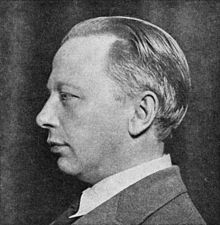6th Symphony (Atterberg)
The 6th Symphony in C major, Op. 31 by the Swedish composer Kurt Atterberg (1887–1974) was written in 1927/28. The work received first prize at the International Schubert Competition in 1928 . The associated $ 10,000 bonus earned the symphony the nickname “Dollar Symphony ”.
Emergence
In 1927 the British-American record company Columbia and the Gesellschaft der Musikfreunde in Vienna announced a composition competition to mark the 100th anniversary of Franz Schubert's death . If the completion of his B minor symphony (the "unfinished") was initially planned, the competitive conditions were subsequently changed several times, until at last only an orchestral work in the spirit of Schubert was required, whereby the Schubert orchestral line-up was to be largely retained.
Atterberg, as a composer a. a. Has already emerged with 5 symphonies and also became known outside his home country, did not find out about the competition until November 1927. However, the submission deadline was extended from the end of 1927 to the end of April 1928 due to multiple changes in the competition conditions. This gave Atterberg the opportunity to complete his 6th symphony , which he had apparently started before knowing the competition. On April 8, 1928, he posted the score. On June 23, 1928, the high-caliber jury awarded the First Prize of the 513 submitted works of Atterberg's 6th Symphony , which was associated with a premium of £ 2,000 or $ 10,000. In addition to the world premiere by renowned performers, a record recording and printing by the Universal Edition were promised.
The prize money soon earned the work the nickname "Dollar Symphony" ("Dollar Symphony"). Atterberg bought a Ford car from it and immediately took driving lessons.
World premiere and recordings
On October 15, 1928, Atterberg's 6th Symphony in C major op. 31 was premiered in Cologne by the Gürzenich Orchestra under the direction of Hermann Abendroth . The award-winning work had already been recorded on August 12, 1928 by the Royal Philharmonic Orchestra in London under the direction of Thomas Beecham for the Columbia record company. Within a short time over 100,000 records (probably 25,000 sets of 4 records each) were sold from the recording. Also in 1928, the composer himself made a record of the work. In 1943 there was another recording under Arturo Toscanini . After that, almost 50 years passed before the Norrköping Symphony Orchestra under Jun'ichi Hirokami re-recorded the 6th Symphony for the BIS label in 1992 , followed by another in 1999 for the cpo label by the Hanover Radio Philharmonic under Ari Rasilainen .
plant
The score provides for the following scoring: 3 flutes (3rd also piccolo ), 2 oboes , 2 clarinets , 2 bassoons , 4 horns , 3 trumpets , 3 trombones , tuba , timpani , percussion , harp , strings (1st violin , 2. Violin, viola , cello and double bass ).
The three movements of the symphony are headed:
- I. Moderato
- II. Adagio
- III. Vivace
The playing time is about 35 minutes.
As with many of the works submitted to the Schubert competition , a connection with the spirit of Schubert is at best loosely recognizable in Atterberg's colorfully orchestrated 6th Symphony , which is in the late Romantic tradition , and the line-up goes beyond Schubert's instruments (larger parts of the symphony were apparently composed, before Atterberg found out about the competition). Swedish-folkloric material can be found in the 1st as well as in the lyrical-elegiac 2nd movement, in which the clarinet emerges as a soloist. Atterberg wrote in a letter to Carl Nielsen that the first two sentences were "written with the greatest seriousness and extremely strict in form" and that they were not influenced by the competition.
The third movement (a rondo ) is different , which begins with a seemingly banal theme that is led to a seemingly learned fugue . “This is how far I had written this sentence before I found out about Columbia's competition, and I found that this joke, devoid of intent, was exactly what I needed as a joke finale for a symphony, if I even got into the competition should participate. I was thinking of the screaming American advertising (and) [...] the invitation to reactionary music-making, which was quite disgusting for the self-esteem of a creative musician, which was contained in the competition regulations. ”In early 1929 Atterberg also wrote one in the Musical Digest (Chicago) The article entitled “How I led the world of music by the nose” stated that the finale of his symphony was “a satire on those people who, in connection with the centenary of Schubert's death, posed as great fans and connoisseurs of Schubert, but without knowledge of or Love for his works. "
These statements by the composer led to headlines such as "£ 2,000 Symphony Hoax" or "Joke of Swedish Composer", which caused considerable resentment among those in charge at Columbia, up to and including Atterberg's request to repay the prize money, which however did not materialize.
Individual evidence
- ↑ a b quot. n. Christoph Schlüren: Foreword to the score of the 6th Symphony by Kurt Atterberg, Universal Edition, 2002
- ↑ cit. n. Stig Jacobsson: CD supplement BIS-CD-553, recording year 1992 (Atterberg: 6th Symphony a.o., Norrköping Symphony Orchestra, conductor Jun'ichi Hirokami)
literature
- Stig Jacobsson: CD supplement BIS-CD-553, recording year 1992 (Atterberg: 6th symphony a.o., Norrköping Symphony Orchestra, conductor Jun'ichi Hirokami)
